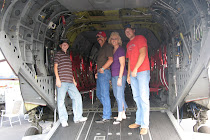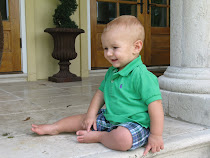
Beautiful view in my bay.
It’s been over a month! Sorry, I have not been on top of things lately.
Candle Making

Lots of women showed up for beeswax candle making.
I taught the women and a few men in the village how to make candles out of beeswax. They were so impressed that the women’s group wants to make them to sell to a handicraft festival this month! New small business, even if it only happens once!
So these are pictures of the women in our community kitchen making candles with molds from America.

Preparing the wick before pouring the wax.

Quality check.
FREE Baby Swing
Here in Fiji, the people have learned how to reuse products extremely well. Some end up in a rubbish pit, but often tin cans are used for ash trays, glass is used to store food, cardboard cartons and plastic bags are reused over and over as well as plastic bottles.

Genius.
Although, I never imagined a flour sack would become a baby swing. This is one of my favorite babies in the village in a handmade basinet/rocker. Isn’t it genius? Just a few sticks, some rope, and a flour sack and you’ve got yourself a free baby swing.
JESSICA TIME

Ah, sisterly love.

Two of my favorite sisters.
The time came and went, fast, too fast. My favorite sister (one and only ) came to visit me over the past two weeks. We had a great time giving each other sisterly advice, entertaining the kids in the village, enjoying Fijian cuisine, and traveling Viti Levu.

The kids driving their homemade car around the village.

Drinking a baby coconut shaped into a cup.

Jessica atop our natural ship.

This is my mushroom rock that I run away to when things get tough.
For the first several days we were in my village hiking to our own secluded beach, snorkeling the village’s protected reefs, swinging on our vine rope into the watering hole, and taking a wet ride on a bilibili.

Her first and only bilibili ride.
The secluded beach was so enticing we had to visit twice!

Jessica and I sharing my hammock at our private beach.
Jessica brought bubbles, a Frisbee, tattoos, and chalk with her to play with the little munchkins.

Playing frisbee with the kids.
They absolutely adored her! The Frisbee was a total hit, everyone in the village wanted a “sticka” (tattoo), the kids had a ball trying to blow their own bubbles, and the chalk ended up on walls of houses, trees, and stones all over the village. We were also invited to several family’s homes for dinner or lunch so she got to try pumpkin leaves, prawn, fried rice, dhal, curry, roti, cassava, rourou, fried fish, and fish in coconut milk.

Jessica gettin roudy with the little grommets.

Giving the kids "stickas" or in our world, temporary tatoos.

They got a kick out of it!

Ever so happy.

Cooking in my adorable kitchen

Sis pulling out the chalk, watch out, they write on EVERYTHING.

On the rocks... for now

Our last grog session with lots of boys around 16 years old. How did that happen?
At The Source

The one and only Fiji Water plant.
After leaving the village we headed to the one and only Fiji Water plant near Tavua, Fiji. This is where the source for all of Fiji Water is. We took a very informative tour from the second floor, viewing down through a glass window. The plant was big, but not nearly as big as someone would imagine when they think of how world renowned the Fiji Water brand is. Americans sure are smart at advertising. It turns out all of the water comes from one horseshoe shaped aquifer that is under the parking lot of the plant. The water that comes in your water bottle is never exposed to outside air. It is filtered then exposed to UV light to purify it before being bottled in Fiji water bottles made on site. The bottles are made from a resin that is shipped in from Thailand. It is dried thoroughly, melted, and then formed into a test tube shape. Next, the test tube goes into a heating machine with a mold for each bottle. The plastic tube is heated, air is blown into the opening, and the bottle expands to the shape of the mold. The mold is made out of metal and is kept cold so that as soon as the warm plastic touches the mold, the plastic hardens. The bottles are filled mechanically. If a bottle is below 498 mL or above 510 mL it is thrown off the line, emptied, and recycled. Otherwise, if the bottle gets dented in the process or the label is crooked, the bottle is given to employees. Everything you never wanted to know about Fiji Water.

At the Source.

Riding the carrier into the interior.
After the village thing was done we headed to the tallest mountain in Fiji, Mt. Tomanivi, also known as Mt. Victoria. Don’t be alarmed, the tallest mountain is only 1232 meters and only took 2 ½ hours to climb to the top.

Starting the hike up, together.

We had to cross a few babbling brooks.
The going got tough at about ¾ of the way up where it had just rained pretty good towards the top of the mountain and everything was slippery mud… and straight up. We had 10 volunteers and one Fijian climb with us, so everyone got separated towards the beginning, but in the end we all gathered at the top, drifting in the clouds.

The view from just below the clouds.

A spider web glistening after a light morning mist.

We all made it to the top of the highest mountain in Fiji!
The flora and fauna were breathtaking, with hundreds of ferns surrounding the trail. As we descended the mountain, loud-squawking red-throated lories dove through the trees above us. The Red-throated Lori is considered a rare species only found in this mountain region, and is therefore listed as an important bird area in Fiji.

The Mine Rest House.
During our stay in the interior, we stayed at an old Mine Rest House for ex-pats during the prosperous gold mining days. The house was very rustic, with four bedrooms, a kitchen, living room, toilet room, and shower. It slept ten and even had a fireplace that we lit up both nights. For 10 FJD ($5.50 US) a night, it was a cute escape!
Next, we checked out a few backpackers resorts.
Robinson Crusoe Island

Our glorious, smelly bucket showers.

There was a hilarious "ceremony" after the crab race to announce the winners. My friend Maika had to present the reward using a trumpet all taped together. Had to be there kinda things.
At Robinson Crusoe we took bucket showers with rain water, but ate food fit for a 5 star resort. There were mekes (Fijian traditional dance, much like Hawaiian dances) at night and during the afternoon, so we enjoyed two amazing shows.

Fire dancing from Samoa.

The daytime show with more fire.

Removing the potatoes from the lovo just before the fire walking. Yes, those potatoes are hot.
Before each feast there was a lovo (Earth oven) which the men removed the cooked food and then performed fire walking. The stones were so HOT. I didn’t believe them until after all the men had done their stunt, they poured water on the stones and they still sizzled. So Jessica and I definitely had to try it out.

Sis, fire walking, that face is for real.

Me, fire walking.
There was also free kayaks, snorkeling, a pool, free 15 minute massage, New Zealand ice cream, and plenty of hammocks.
Kula Eco Park


I want to eat you!
Not too impressed. Nice park with some iguanas, parrots, and sea turtles.

Jessica playing tongues with the boa constrictor.

Na beka, a fruit bat. They only had two at the park... but there are thousands in my village.

Who you lookin at?

Another banded iguana who is a messy eater.

A banded iguana.
The BeacHouse
Then we headed on to BeacHouse on the Coral Coast. We were totally impressed. For about $18 US a night we had a posh common area with a pool table, ping pong, hammocks, a pool, a neat bamboo swing, and plenty of activities to keep us busy.

I am so building one of these near my village.

The awesomest swing you have never swung on!
The desserts were to die for and they supplied a kitchen for backpackers to cook their own food (although, the kitchen was not advertised as well as their surfing lessons, horseback riding, and one hour massages ($12 US). The happy hour made a 16 oz mug of Fiji Bitter about 1.75 USD. Overall, I was impressed and all of the volunteers on Viti Levu will be returning for Halloween!

The Sri Siva Subramaniya Swami Temple on Main St. Nadi.
Our trip came to an end before we even realized it had begun. We headed back towards Nadi, did some souvenir shopping, and I sent her off on the 757. It was a nice trip that I wished lasted longer. Miss you terribly, Sissy!
Kindy Update

The kindy on a fieldtrip to collect sand - the topic of the week - their choice!

Learning about sand.

Using one of their gifts from First Christian Church of Gainesville, Texas, magnifying glasses to identify what the sand is made of.

Walking through the village.
Footpaths Already on the Move

A three year old sister of mine, Wati, helping collect gravel.

My 72 year old Grandfather dumbing his first load of gravel at our collection site.

My 73 year old Grandfather shoveling sand into the youths' pig feed sacks.

Grandfather and grandson collecting gravel together.
The men of the village have begun collecting sand and gravel for the footpath project. Only problem, I am still lacking about $2500 US for our project. They are now asking when they should expect the financial assistance and I can only tell them that we are still waiting. Does anyone have any good ideas on how to raise this money fast? I have thought about an ad in the newspaper, but there has to be a better solution. Otherwise, if anyone would like to help, please visit the URL below:
www.peacecorps.gov/donate
Once here, search for project number 411-146 or country “Fiji”.
Thank you everyone who has already donated and I look forward to sending out Thank You letters soon!

Carrying the sand from near the rocks in our bay into the village.

The youth cleaning the sand.


















No comments:
Post a Comment